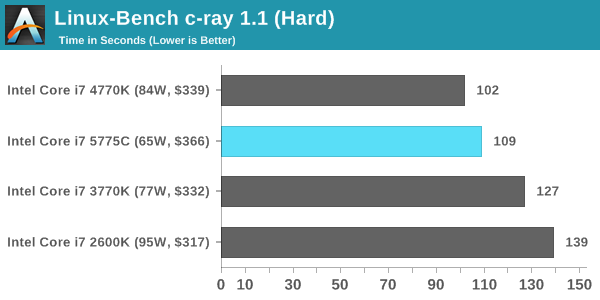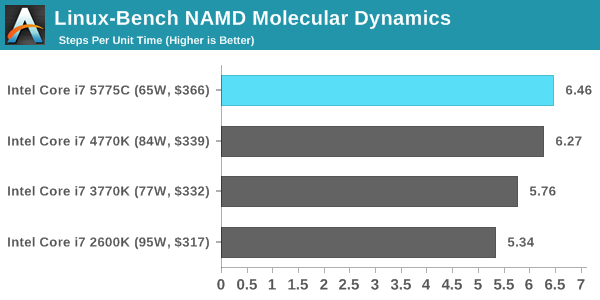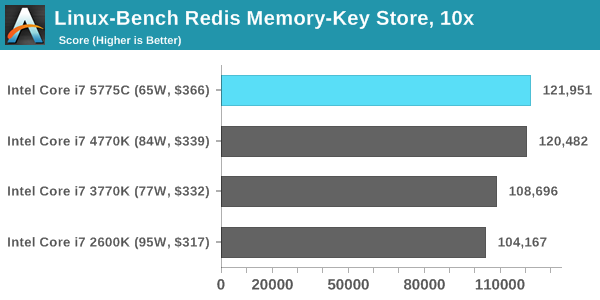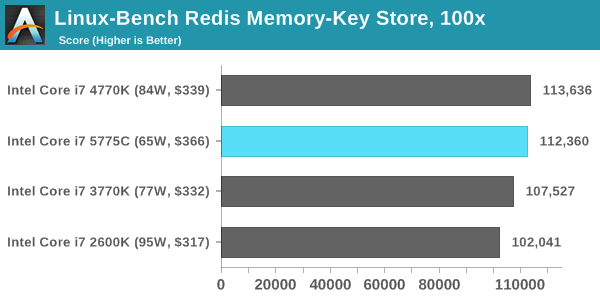The Intel Broadwell Review Part 2: Overclocking, IPC and Generational Analysis
by Ian Cutress on August 3, 2015 8:00 AM ESTLinux Performance
Built around several freely available benchmarks for Linux, Linux-Bench is a project spearheaded by Patrick at ServeTheHome to streamline about a dozen of these tests in a single neat package run via a set of three commands using an Ubuntu 11.04 LiveCD. These tests include fluid dynamics used by NASA, ray-tracing, OpenSSL, molecular modeling, and a scalable data structure server for web deployments. We run Linux-Bench and have chosen to report a select few of the tests that rely on CPU and DRAM speed.
C-Ray: link
C-Ray is a simple ray-tracing program that focuses almost exclusively on processor performance rather than DRAM access. The test in Linux-Bench renders a heavy complex scene offering a large scalable scenario.

NAMD, Scalable Molecular Dynamics: link
Developed by the Theoretical and Computational Biophysics Group at the University of Illinois at Urbana-Champaign, NAMD is a set of parallel molecular dynamics codes for extreme parallelization up to and beyond 200,000 cores. The reference paper detailing NAMD has over 4000 citations, and our testing runs a small simulation where the calculation steps per unit time is the output vector.

NPB, Fluid Dynamics: link
Aside from LINPACK, there are many other ways to benchmark supercomputers in terms of how effective they are for various types of mathematical processes. The NAS Parallel Benchmarks (NPB) are a set of small programs originally designed for NASA to test their supercomputers in terms of fluid dynamics simulations, useful for airflow reactions and design.

Redis: link
Many of the online applications rely on key-value caches and data structure servers to operate. Redis is an open-source, scalable web technology with a b developer base, but also relies heavily on memory bandwidth as well as CPU performance.













121 Comments
View All Comments
TheinsanegamerN - Monday, August 3, 2015 - link
Quite nice comparison.Unfortunately, it seems that, while broadwell does have the best IPC of the bunch, the overclock is pathetic. 1.325v to hit 4.2 GHz? my ivy bridge 3570k does the same clock with 1.075v. now, I've been told I have a exceptionally good chip, but it strikes me as odd that broadwell, being on a smaller 14nm process, cant match what ivy bridge could do two years ago. and since sandy bridge can be OC'ed to 4.7GHz+ with ease,and ive can hit 4.5, it seems there is still no reason to upgrade to broadwell, as any IPC gains are cancelled out by the lower clock rate. unless you need to do lots of dolphin emulation and refuse to overclock at all, the ancient sandy bridge still seems to do the best.
K_Space - Monday, August 3, 2015 - link
TheinsanegamerN agreed. Those who held into their Sandy made a very wise investment, just like those good ol' 920s back in the X58 era.Dupl3xxx - Monday, August 3, 2015 - link
Ah, yes, the 920 was a lovely beast. Started overclocking at 3.6. It booted, tried 3.8, booted, tried 4.0, failed. 3.8 was literally done in less than an hour as my second ever attempt at overclocking, with my first being the intel e6600. And when a dying PSU wounded it, I got a 3930k. It does 4.0 ghz, and I've yet to find any situation where it's a bottleneck, besides things like rendering and benchmarks. I considered upgrading to the 59xx series, but when I learned that only the 5960x would be a 8-core, that was quickly decided against.It'll be interesting to watch Skylake and Zen fight it out in a year or so.
Impulses - Monday, August 3, 2015 - link
I'm surprised Intel isn't banking on nostalgic memories of the Q6600 to hype the 6600K & 6700K... Surely marketing had a hand in the simplified naming reminiscent of the old C2Q.augiem - Monday, August 3, 2015 - link
I'm still on a i7-920 from mid 2009. Been running 3.6GHz the entire time, still rock solid as the day I bought it. I still can't believe I've been using a PC for this long. Before the i7, I would upgrade every 1.5 - 2 years tops. This thing is nuts.mkozakewich - Tuesday, August 4, 2015 - link
We've reached the end of that exponential advancement, so you can expect things to advance at roughly this rate for a while, at least until we also reach "small enough".close - Tuesday, August 4, 2015 - link
That's logarithmic advancement :). It keeps slowing down year after year.Cryio - Tuesday, August 4, 2015 - link
Technically with Sandy Bridge they reached the end. SB was quite a jump over Nehalem.Harry Lloyd - Tuesday, August 4, 2015 - link
There is no end. Intel just do not care, as they have no competition. Why would they waste money on increasing performance, when they can focus on efficiency for mobile? They can get away with selling basically the same CPUs every year on desktop, as they are still the fastest.Badelhas - Tuesday, August 4, 2015 - link
I also blame AMD. If they had good high end CPUs Intel would be forced to improve the ones they´ve been selling for the last 5 years or so.